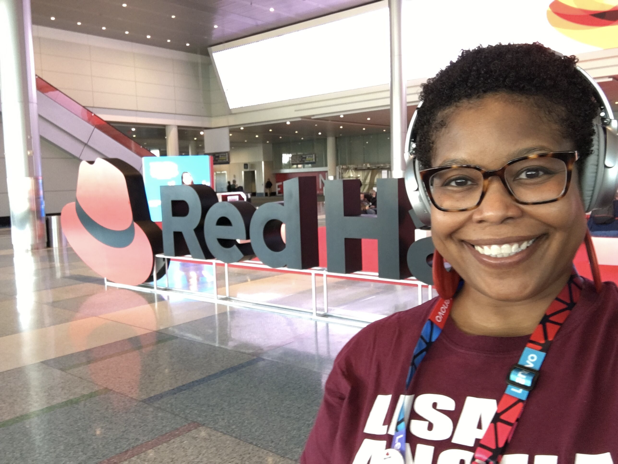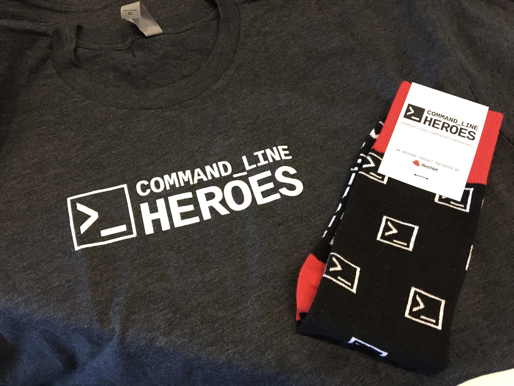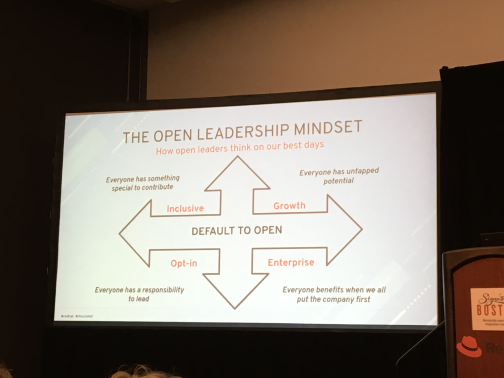I’m just settling back into the office after attending my first Red Hat Summit. What an adventure!!! When I first walked into the Boston Convention Center, I knew I was in the right place. Welcomed by red carpets everywhere and the spiffy new logo, with a nod to accessibility right as I entered, I knew I was where I was supposed to be. My flight got me in Monday afternoon and made it to the First Timers Reception. After I picked up my registration badge and backpack, took obligatory selfies, I headed to the shindig.
A huge breakout room with a multiple bars, food stations on my left and right and wait staff walking around with snacks, this room was buzzing. I knew for certain I didn’t know anyone here, so I grabbed a beer and looked for a place to hang out. Almost immediately, I was chatting it up with a few guys who were Red Hat Accelerators.
Red Hat Accelerators are defined as:
“The Red Hat Accelerators (RHA) program is a global customer network of Red Hat (RH) technology experts and enthusiasts who willingly share their IT knowledge and expertise with peers in the industry, the community, and with Red Hat.”
From Red Hat
We did intros, laughed and talked until the end of the reception. One guy asked if I’d be interested in becoming an accelerator and gave me a card that had a QR code on it to find out more about the program. I was sure I wasn’t interested, but I took the card anyway and promised to check it out.
I didn’t get into many of the sessions I’d hoped to. I’d built my agenda in advance, but so many were filled up very fast. Success struck on a few, so I was able to build an agenda that kept me busy all week. Here is a peek and some of the sessions I attended.
Day 1
Winning With Red Hat Enterprise Linux- As told by Our most fanatical customers. (slides)
Wouldn’t you know, I few of the guys I’d met at the reception was on this panel. It was moderated by Marc Richter, a Red Hat Senior Technical Account Manager (TAM) and it was a Q&A about all things Red Hat. The panel talked about their joys and pain points of using RH and features and services they’d like to see improve. It was a lively session and it was really a great way to ease into the fire hose that was about to open on me.
Making DevOps managed services work for you
Another panel that talked about how they are implementing DevOps in their environment. I heard so many buzzwords, but one that kept being repeated was ‘velocity’. The context clues gave me an idea, but I was so surprised at just how many times it was being uttered. I guess DevOps = Velocity. However, all I kept thinking about was the Velocity Conference that was coming in June and that I wouldn’t be going to because I was slated to attend AWS Public Sector Summit in DC at the same time.
Move at the speed of DevOps:
This session really piqued my interest. I’m new to DevOps and I’ve been tasked with developing an environment for our developers and this seemed like the place to start. Greeted with a full house, I guessed so many others were in my boat and wanted to learn more. Text heavy slides with small fonts that I couldn’t make out, I tried to take a few photos to record some of the nuggets. Sadly, I couldn’t read them and they hadn’t released the slide deck as I’m writing this post. One acronym they went over was PACE, which focused on 4 key pivots on the path to DevOps:
- Process
- Architecture
- Culture
- engineering
As the talk when on, it started to feel more and more like a sales pitch. I even asked the guy next to me and he felt the same way. The slide deck hasn’t been released yet for this talk, but I’ll surely keep my eye out for this one.
Pulling the puppet strings with Ansible: (slides)
Although this was only a mini session, I wanted to attend to see what could be done with both Puppet and Ansible. We currently use Puppet for configuration management for Linux systems, but I’m 1) looking for more insight into Puppet and 2) Discover how the two can work together. This session talked about how Red Hat started with CFEngine first, and the migration to Puppet. Puppet language is hard to learn and dependency ordering proved challenging. It was also slow and didn’t scale well. After 10 years with Puppet, they found it even harder to learn and updating modules to 5.x was nearly impossible.
Then they moved to a hybrid approach with Puppet and Ansible. Ansible was great for orchestration and ordering dependencies was much easier. You just wrote the playbook and you were on your way. Ansible was also much easier to learn. Then came Ansible Tower. With the ability to centralize playbook execution and manage credentials, Ansible became an important part of configuration management. However, it was not going to replace Puppet. Hiera proved better at managing environment data and Puppet ERB templating was better than Jing2. If you don’t use Ansible Tower, centralized auditing could prove challenging.
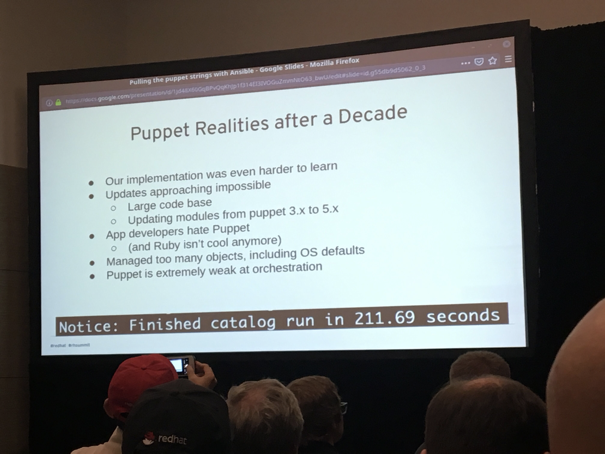
Red Hat has a podcast that I listen to called, Command Line Heroes and its hosted by the one and only Saron Yitbarek of #CodeNewbie fame. They had a space set up at at the conference and with command line video games, interviews for the podcast and 2 people doing caricatures. I did a quick interview and had my caricature drawn as I talked. Pretty neat, huh?
Desperately seeking DevOps: How do you change the way you work? (notes)
This session wasn’t what I was expecting. It was a “birds-of-a-feather” session which meant you were in a room with other Red Hat customers that were also desperately seeking DevOps. This session started kind of like an ‘unconference’, where you wrote down topics that you’d like to talk about and the attendees would vote for 3 suggestions each by putting a dot on the post-it note that had an idea they would be interested in talking about. One of my topics got picked for discussion. You’ve decided on the DevOps approach, now what? Sadly, it was less about what tools folks were using and the onboarding involved, but more about how to change the culture in order to even begin the process. Bigger organization seemed to have much more friction with changing mind sets than anything else. One company did find success with making sure teams were trained. They took time to level the team up with workshops on things like Python, learning the tools, etc. More time up front yielded better results from the teams involved. Also, developers had to be included in this training because they had to learn and be responsible for their role in the pipeline.

At the end of a very long day, they held the General Sessions which lasted 2 hours. Seating was difficult so I sat on the floor in the back of the hall. After that became impossible, I found the Active Lounge. It was empty and had a TV casting the session. I put my feet up and watched. There was a conversation between the Red Hat CEO, Jim Whitehurst and IBM CEO, Ginny Rometty. Fun fact, I met Ginny at Microsoft Ignite in 2017. There was a women’s lunch during the conference and it was very well attended. I’d registered well in advance, but it was hard to find seating. As the usher walked me around the room, Ginny invited me to sit at her table with her and her colleagues in the front of the room. It was an honor and a very nice gesture. Of course I stuck out like a sore thumb in my jeans and t-shirt while the ladies were resplendent in their dresses and suits, but I didn’t care, I had the best seat in the house! Anyway, I digress. They spoke about the history of open source and how both companies invested in it over the years. Jim said, “Open source is the vehicle for innovations that matter” and that got a big round of applause. Ginny got her own round of applause when she said, “We’d like to keep Red Hat separate”.

Another great conversation was Jim speaking with Satya Nadella, the CEO of Microsoft and their commitment to open source, the flexibility of hybrid and edge cloud. There was also the big announcement of general availability (GA) of the Azure Open Shift Service. Many CEOs got on stage and talked about how they’re using Red Hat products to further their own innovations. Other big announcements were GA for Red Hat Enterprise Linux 8 (RHEL 8), the Red Hat Universal Base Image (UBI) and Red Hat Insights adding support for Microsoft SQL Server for Linux.()
As the keynote wrapped up, the welcome reception that followed was held in the expo hall. Vendors we’ve all heard of had booths and plenty of swag to give away.
Day 2
Mental shift from system admin to system architect:
This session was more from the move from sysadmin to leading a team, but I found some nuggets that proved helpful. Thinking in terms of growth for the team and identifying my own strengths and weaknesses aids that shift. Also keeping up on tried and true technical skills as well as developing new skills. Lastly, creating a roadmap for future growth and reviewing it often to stay on track.
Next, I rounded off my morning with 2 session on open organizations and open leaders.
Giving people a voice in an open organization: (slides)
We’ve all been in an organization where there is one person that is always talking and there are some folks that never speak up. This session focused on how to “create an environment where everyone is heard equally”. Led by 2 Red Hat staffers, this session talked about processes that helped teams communicate better and “collaborate on equal terms regardless of tenure”. This session spoke to me. I’ve seen this dynamic where there is someone that is always talking and over the years, I’ve tried to be the person in the room that pays attention to faces. Sometimes faces change with they agree or disagree with something that’s being said. I try to direct questions to people who look like they have something to say and keep them included in the conversation. I know how it is to be the quiet one in the room and those small gestures are sometimes just enough to make a space more inclusive.
Beyond engagement: What open leaders need to know about empowering others (slides)
This session followed up the previous session quite nicely. Led by another Red Hat employee, this one talked of how we empower individuals just as much as we empower teams. She talked about how leaders should build other leaders to both further the growth of the company but also, growth of the individual. This helps “every individual reach his or her potential”. She provided a link to the open organization maturity model, a framework that Red Hat uses to help teams, individuals and the organization as a whole become more transparent and inclusive.
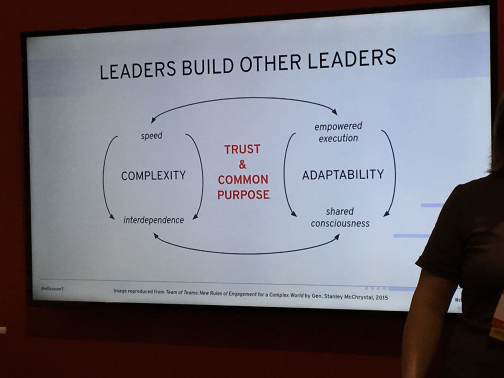
One thing this session reminded me of was Proverb 27:17 As iron sharpens iron, so one person sharpens another.
Puppet and Ansible in Foreman:
This session was in the community theater in the expo hall and the sound was so poor, I couldn’t hear the speaker. I didn’t know what Foreman was, so I had to look it up. Foreman is a server lifecycle management and orchestration tools. It is commonly used with Puppet and Chef. It would have been nice to learn more.
Since I was in the expo hall, I skipped my last session of the day and explored the expo hall. I took some hands-on demos in the Red Hat Booth and got t-shirt for completing each one. Once you did 3, you got a hoodie as a bonus!
Day 3:
Centos 8 and Beyond:
This was another session held in the expo hall and it was hard to hear the speaker. It was mostly a Q&A between the speaker, a Red Hat employees who works on the Centos project and the audience. There is no ETA on the release of version 8, but it’s coming. There was an overview of the build process, how Centos is working with Fedora as well as the steps to get it to GA.
Open Management: The next frontier in open culture:
This was a panel discussion of Red Hat managers and they did a Q&A on how they are using the open culture to support teams and individuals as well as how managers are still necessary and what part they play in an open culture. They’d have a question on a slide and each manager got a chance to reply. A few nuggets I took away were that empathy is a necessary quality in a manger. How can you manage humans if you have no empathy? Not having a empathetic manager is a cancer IMO. Why would you even try if your manager doesn’t exhibit empathy. If they don’t care, how can you?
In between sessions, I check twitter and I’d discovered that Linux Academy just added RHEL 8 to the cloud playground!

Manage Windows with Ansible: The what, the why, and the how? (slides)
This was the session I’d looked forward to the most. I want to do more automation in deploying Windows systems here, and we’re just not there yet. I’d already heard about how well Puppet and Ansible work together, but this session just focused on Ansible and Windows. There were a few code examples on how the declarative language of Ansible can help build, patch, secure and configure Windows systems. Also, tips on software management and how great PowerShell DSC is with Ansible. After sitting through this packed session, It was good to know that Linux wasn’t the only party in town and the automation pain points for Windows administration still exist, but there are ways to make it easier with Ansible. However, learning PowerShell and DSC and even more python are in order. To make writing playbooks even easier, there is a an Ansible extension for Visual Studio Code.
There was a call to action at the end of the talk to “Learn how to Ansible”. I’d used Ansible for Linux in a test environment before, but never in production and NEVER for Windows. I think I’ll take his advice and wade in.
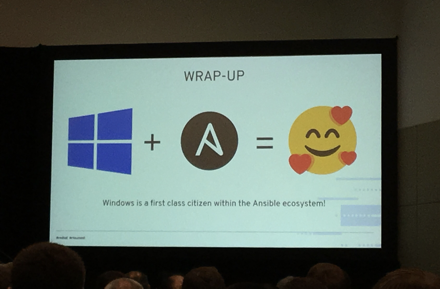
Security-Enhanced Linux for mere mortals:
I’ll admit it, I don’t get SELinux. It has been something always caused more problems that it solved IMO. As a mere mortal, I signed up so I could get a better understanding of how to enable it and not break everything. The speaker understood the pain point of how hard it was to even grasp SELinux, the documentation is the beginning was downright horrible, but over the years, it has gotten better and SELinux is much easier to manage.
He showed scenarios and demos on how to configure, set rules and policies and troubleshoot SELinux issues. I had to agree, it did SEEM easier in the situations he’d presented, but more understand would definitely be needed. I’d thought I would be able to walk away from the conference without one snarky comment about Windows Admins, but I was wrong. He had to throw in the tired old trope, “It’s so easy, even an Windows Admin can do it” at the very end. Alas, no conference is ever perfect.

I’d learned quite a bit about what tools and services Red Hat and the ecosystems surrounding them provide. There were so many that I hadn’t even heard of before, but I guess that’s why you go to conferences, to gain a new insight on what’s possible and find out more about things you only know by name. I’m looking forward to attending again. It was a great experience. Who knows, maybe next year I’ll be back as an accelerator.

